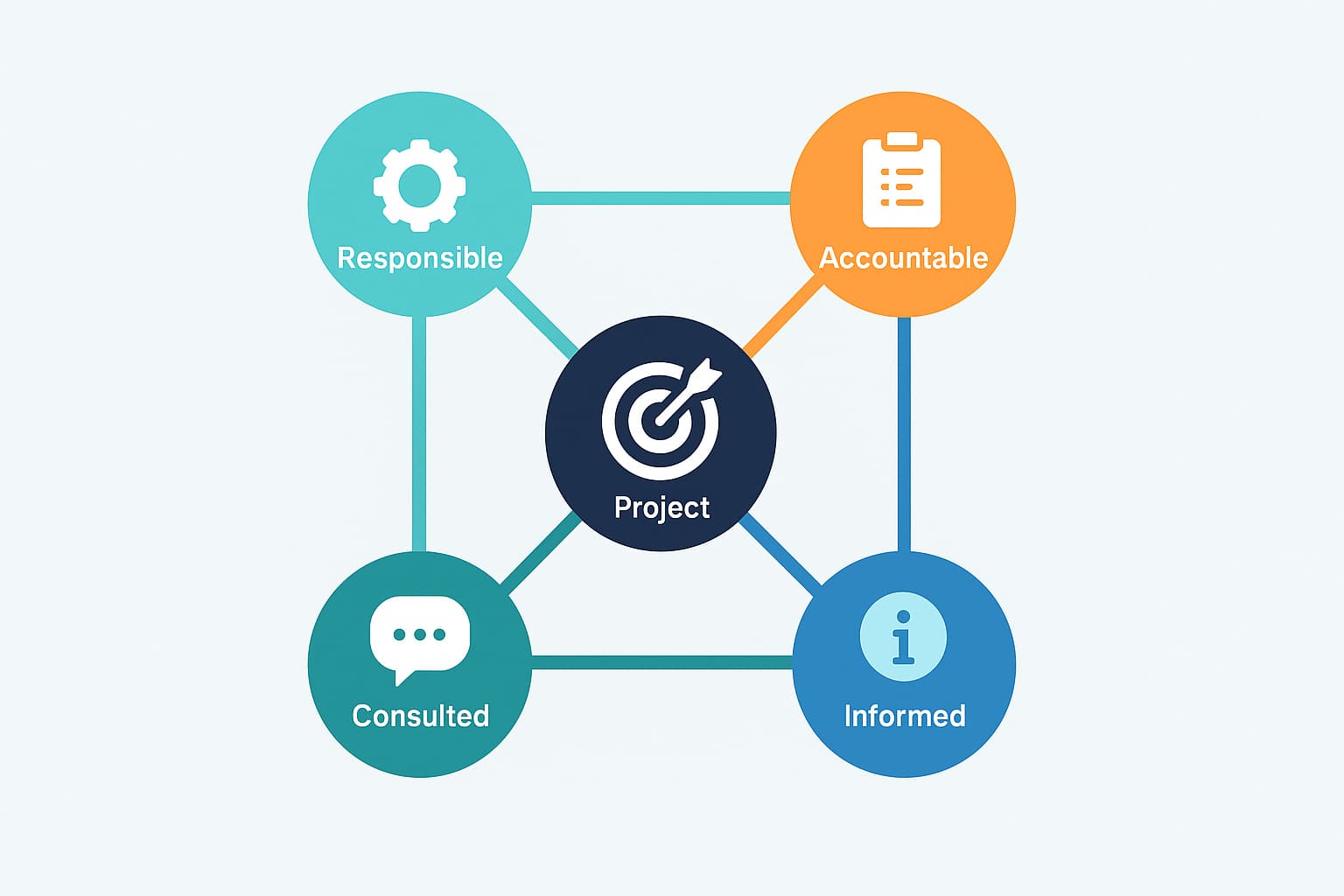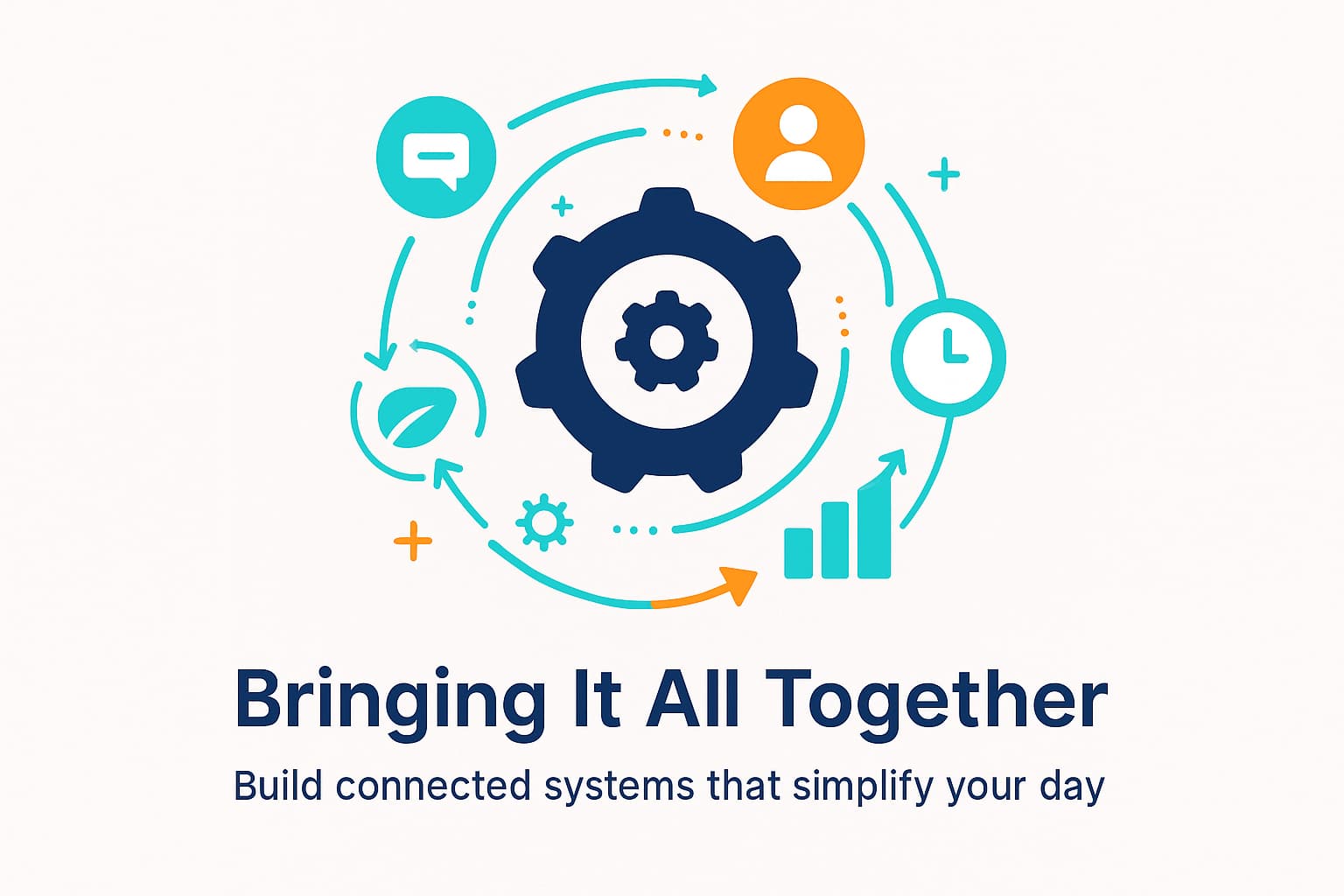7 Strategies to Improve Small Business Operational Efficiency
by

- What Operational Efficiency Really Means (and Why It Is a Big Deal)
- 1. Streamline and Standardize How You Work
- 2. Automate the Repetitive Stuff
- 3. Use Tools That Actually Make Life Easier
- 4. Get the Right People Doing the Right Work
- 5. Keep Training (and Listening to) Your Team
- 6. Delegate Without Micromanaging
- 7. Set Goals You Can Track (and Celebrate Wins)
- Bringing It All Together
- Conclusion
- FAQs
The truth is, the businesses that grow consistently are not necessarily the ones that push the hardest. They are the ones who figure out how to make things flow more easily, finding ways to work smarter, not endlessly harder.
That is where operational efficiency really comes in. It is about getting work done without the daily chaos, building simple habits that save time and mental energy, and keeping your team focused on the work that truly moves your business forward.
So let us walk through seven practical, real-world strategies that can help you create more breathing room and run your business with a little less stress and a lot more intention.
What Operational Efficiency Really Means (and Why It Is a Big Deal)
Operational efficiency is really about working in a way that gives you back time and headspace. It is not about perfection; it is about progress.
When you focus on efficiency, you:
- Stop wasting time on low-impact tasks.
- Cut unnecessary costs without cutting corners.
- Help your team stay focused and consistent.
- Give your customers smoother, faster experiences.
According to McKinsey, small businesses that tighten up their systems see a 30% jump in productivity within a year. Imagine what you could do with that kind of breathing room. Maybe finally launch that side project or spend more time connecting with customers instead of managing spreadsheets.
That is exactly why understanding operational efficiency matters. From here, we will turn those big ideas into practical strategies you can start applying in your everyday operations.
Before we dive into the details, here’s a quick snapshot of what efficiency looks like in action. The table below compares common challenges small businesses face with the results they see after improving their processes.
| Challenge | Before | After Efficiency Improvements |
|---|---|---|
|
Lead response time |
2–3 days |
Replies within the first few minutes |
|
Missed deadlines |
Too common |
Rarely, automation keeps you on track |
|
Data entry |
Manual and repetitive |
Auto-synced and reliable |
|
Team collaboration |
Siloed |
Aligned and seamless |
1. Streamline and Standardize How You Work
Here is the truth. If everyone on your team has their own version of how things should get done, chaos is not far behind. The first step to efficiency is simply knowing how things really happen day to day.
Ask yourself:
- What tasks keep showing up again and again?
- Where does work get delayed or dropped?
- Who is actually responsible for each step?
You might realize that half your team is solving the same problem in three different ways. Once you map it all out, you can start cleaning it up, combining similar tasks, cutting unnecessary steps, and building one clear path everyone follows.
In fact, a small accounting firm discovered that each partner had been using their own client onboarding checklist. Once they built a single shared version and linked it to automation triggers, such as sending forms or scheduling calls, the difference was immediate. They started saving hours each week while offering clients a smoother, more consistent experience.
Tools like Pulse CRM make this easier by keeping all communication, tasks, and notes in one place. Less confusion. More flow.

2. Automate the Repetitive Stuff
You know that sinking feeling when you realize you have spent your whole morning doing the same admin tasks again? That is where automation saves the day. It is not about robots taking over; it is about giving yourself and your team the freedom to focus on work that actually matters.
Here are a few easy automation wins:
- Lead Management: Auto-capture leads from forms or emails into your CRM.
- Follow-Ups: Send friendly reminders or thank-you emails automatically.
- Task Assignment: Trigger new to-dos when deals move into your sales pipeline.
One Pulse client, a small cleaning business, automated everything from quote requests to hiring new staff. This mattered because it completely changed how they worked. Overnight, their lead-to-hire process ran on autopilot, freeing up hours that had been lost to admin work and giving their team more time to focus on serving customers.
The table below highlights a few areas where small business teams often save the most time once they start automating key tasks.
| Area Automated | Time Saved/Week | Outcome |
|---|---|---|
|
Lead capture
|
3–4 hours |
No more missed inquiries |
|
Quoting |
5 hours |
Reduced time creating new quotes |
|
Staff onboarding |
11 hours |
Faster, smoother hiring process |
Start small. Pick one repetitive process and automate it. You will be surprised how much lighter your week feels.

3. Use Tools That Actually Make Life Easier
Technology should make your workday easier, not leave you buried under logins and browser tabs. If your team is constantly jumping between tools just to get one task done, it is a sign that your systems need some attention.
The right tools do not just organize your work; they create space for better thinking, smoother communication, and faster decisions.
Here is what to look for when picking the right tools:
- Integration: Choose tools that work well together so data flows easily between them. That means no more copying and pasting client information from one app to another. Systems that integrate help you see the full picture in real time.
- Adoption: Go with platforms your team will actually enjoy using. If the software feels clunky or confusing, adoption drops fast. The best tools are the ones your people log into without hesitation because they make their jobs easier.
- Visibility: Use technology that gives you insight into what is working and what is not. You should be able to see project updates, sales performance, or customer progress without chasing anyone down.
This matters because scattered systems are one of the biggest time drains in small businesses. A report from Harvard Business Review found that employees lose up to 20% of their time just searching for information across disconnected platforms. When you have one reliable source of truth, decisions come faster, and collaboration feels effortless.
Technology should feel like a teammate, not another to-do. A simple, connected setup lets you manage leads, track tasks, and review performance all in one view. That clarity gives everyone, from leadership to front-line staff, a sense of control and focus.
If you are not sure where to start, look at how your current tools communicate with each other. Ask, “Can this system talk to the next one, or are we filling the gaps manually?” That one question will often uncover where your real inefficiencies live.
You can also explore ways to connect your sales and operations data using Pulse CRM. The goal is not to add more tools, but to make the ones you already have work better together. When your technology fits naturally into your workflow, your team spends less time managing tools and more time moving the business forward.
Let Us Help You Get Started!
Pulse CRM delivers more than software. We’re your partner in success.
We fully set up your CRM, including importing your data, configuring sales and marketing automations, designing branded email templates, writing engaging email copy, setting up sales pipelines, and much more.
4. Get the Right People Doing the Right Work
Getting the right people focused on the right work is one of the simplest ways to boost efficiency, but it is also one of the hardest to master. Many small businesses grow quickly and end up with team members wearing multiple hats. That can work for a while, but over time, it creates confusion, burnout, and gaps in accountability.
To start fixing this, take a step back and look at your team structure. Ask yourself:
- Who is doing work that does not match their strengths?
- Which tasks could be handed off, automated, or paused altogether?
- Are responsibilities clear enough that everyone knows who owns what?
Clarity builds momentum. When everyone understands their role, things move faster and with fewer mix-ups. According to Gallup, employees who know what is expected of them are about 30% more productive and far more engaged. That kind of clarity might seem simple, but it can completely change how a team performs.
If you are not sure where to begin, take a closer look at a recent project. Follow each step from start to finish and note where the process slows down or communication breaks. Each handoff is a chance to simplify.
If approvals always get stuck with one person, consider whether a small team could handle those decisions instead. Often, it is not about adding new people, but about giving your current team the space and trust to do their best work.
A practical way to define roles is the RACI model (Responsible, Accountable, Consulted, Informed). It helps everyone know who does what and where they fit in. The person responsible does the task. The accountable person signs off. Those consulted share input, and those informed stay updated. Using this model consistently helps small teams avoid confusion and unnecessary back-and-forth.
You can also make role ownership more visible with tools like Pulse CRM. Assigning tasks and tracking accountability digitally saves time and reduces the need for repeated check-ins or status updates. When people work in ways that suit their natural abilities, confidence grows, collaboration improves, and productivity follows.

5. Keep Training (and Listening to) Your Team
Even the smartest systems cannot fix poor communication or a lack of understanding. Training is not a one-and-done task; it is how you keep your team aligned, confident, and capable of adapting when things change. The most efficient teams are the ones that treat learning as an ongoing habit, not an occasional event.
Here is what works best:
- Short, focused refreshers: When new tools or processes roll out, keep training simple and practical. A 30-minute hands-on session is often more effective than an all-day workshop.
- Explain the why: People buy into change when they understand the purpose behind it. If your team knows why a new workflow saves time or improves accuracy, they are far more likely to use it consistently.
- Open feedback loops: Encourage your team to share what is working and what is not. Often, the people using a system every day are the ones who see its hidden flaws or unexpected strengths.
According to LinkedIn Learning, companies that make learning part of their culture see 30–50% higher employee engagement and retention. When people feel supported in developing their skills, they are more likely to stay motivated and contribute new ideas.
Regular check-ins can help you spot skill gaps before they start affecting results. Maybe someone shines when talking to clients but struggles with data tools. Pairing them with a teammate who’s stronger in that area or giving them a quick, focused learning session can make a huge difference.
Technology can make this process easier. A good CRM or project management system can show patterns that might otherwise go unnoticed.
When your team feels heard, they are more likely to stay engaged and open to learning. Ask what makes their work harder than it needs to be and what would make it smoother. Then act on their feedback. When people see their input shaping real change, training stops feeling like a chore and starts feeling like teamwork.
6. Delegate Without Micromanaging
Delegation is tricky. You want things done right, but checking every detail can slow everything down. The goal is not to give up control, but rather to share it.
To delegate effectively:
- Hand off repeatable tasks with clear instructions.
- Explain why the task matters, not just what to do.
- Use shared dashboards to track progress (no more “just checking in” emails).
According to Pulse data, a marketing consultant was spending six hours a week updating reports. Once she trained her assistant and built a repeatable workflow, everything started to shift. She gained that time back, used it to focus on client strategy, and in turn, her clients received better service.
| Delegation Stage | Common Mistake | Better Approach |
|---|---|---|
|
Assigning work |
Giving no context |
Explain purpose and outcomes |
|
Checking progress |
Micromanaging |
Use shared dashboards and pipelines |
|
Feedback |
Sporadic |
Quick, ongoing conversations |
When delegation feels like teamwork instead of supervision, everything runs much smoother.

7. Set Goals You Can Track (and Celebrate Wins)
You cannot fix what you do not measure, but you also do not need to overcomplicate it. Setting clear, measurable goals gives your team direction and purpose. It turns daily work into progress you can see and celebrate.
Here are a few good examples:
- Cut admin time by 15%.
- Reply to new inquiries 20% faster.
- Shorten your sales cycle by two days.
Goals like these are specific enough to measure but simple enough for everyone to understand. They also create accountability without adding unnecessary pressure.
According to Harvard Business Review, teams that set clear, achievable goals are 50% more likely to hit performance targets than those that rely on vague intentions.
Once you set goals, make them visible. Use dashboards or shared reports so everyone can see progress in real time. This transparency builds motivation because it turns success into a team effort rather than an individual win. When someone hits a milestone, call it out. A quick acknowledgment in a meeting or internal chat can go a long way in keeping morale high.
It also helps to break large goals into smaller checkpoints. For example, if your quarterly goal is to improve response time, set weekly mini-goals that track incremental progress. Those small wins build momentum and make the bigger goal feel achievable.
Consider reviewing your metrics weekly or biweekly instead of waiting for end-of-month reports. Teams that check their performance regularly tend to spot issues earlier and adjust faster. This steady rhythm of review and refinement keeps everyone aligned and focused.
Let Us Help You Get Started!
Pulse CRM delivers more than software. We’re your partner in success.
We fully set up your CRM, including importing your data, configuring sales and marketing automations, designing branded email templates, writing engaging email copy, setting up sales pipelines, and much more.
Bringing It All Together
Efficiency is not about doing more; it is about doing what matters most with less chaos. Every time you fix a small pain point, you are making your business stronger and your days easier.
Start where you are, clean up one process, and automate one task. Have an open conversation about what is slowing your team down. Those little steps add up, and before you know it, things just start to click.
Remember, the goal is not perfection; rather, the goal is progress that sticks.

Your Next Steps Toward Smarter Operations
Here is how to keep your momentum going:
- Look closely at how you work. Shadow your team for a day or map your own tasks. Where do things stall or repeat? That is where your opportunities live.
- Pick one workflow to fix. Do not try to solve everything at once. Start with one process, like client follow-ups or onboarding, and make it better.
- Review quarterly. Sit down with your team every few months to ask what is working and what is not. Those small tweaks keep you agile.
- Tie efficiency to impact. Time saved is great, but what you do with it matters more. Use that space to grow, serve clients better, or take a breath.
If you want more ideas to spark your next round of improvements, check out our blog. It is full of real-world strategies to help streamline business processes.
Conclusion
Operational efficiency is more than a buzzword; it is about how you run your day and your business so that things just flow better. When you make it easier for your team to work together, remove the small stuff that slows everyone down, and stay focused on what actually moves the needle, everything starts to feel smoother.
The real win is not just saving time, it is having the breathing room to focus on what truly matters: your customers, your growth, and the kind of work that energizes you and your team.
Each small improvement adds up. Over time, they build a business that runs with less effort and more intention. So as you start applying these ideas, keep things simple, stay consistent, and trust that progress comes from steady, thoughtful change.
Ready to make your workday easier and build systems that really support your business?
Book a free 30-minute demo with Pulse CRM to see how smart automation and a practical setup can help your team save hours every week.
FAQs
Most inefficiency comes from small, fixable problems that build up over time. Manual data entry, unclear responsibilities, or too many disconnected tools can quietly eat away at productivity.
Automation takes care of the tasks that slow you down, such as sending reminders, logging customer interactions, or updating reports. It helps your team focus on meaningful work instead of repetitive admin tasks. Think of it like adding a reliable team member who never forgets a step or takes a day off.
Start small and observe your current process closely. Follow one task or project from beginning to end and take note of where things stall or repeat. This matters because efficiency improves fastest when you fix what happens most often. If you notice bottlenecks in communication or repeated manual work, focus your first changes there. Small, targeted improvements often create the biggest ripple effect across the business.
Quarterly reviews work well for most small businesses. They give you time to collect real data without letting inefficiencies pile up. During each review, ask your team what slowed them down and what tools or steps could be improved. This light but consistent rhythm helps keep operations sharp without adding more meetings to your schedule.
Culture has a bigger impact on efficiency than most leaders realize. A team that feels comfortable raising concerns or suggesting changes will naturally spot problems earlier. When people trust each other and leadership listens, efficiency becomes a shared responsibility, not just a management goal. Building a culture of open communication turns improvement into an everyday habit rather than a once-a-year project.





